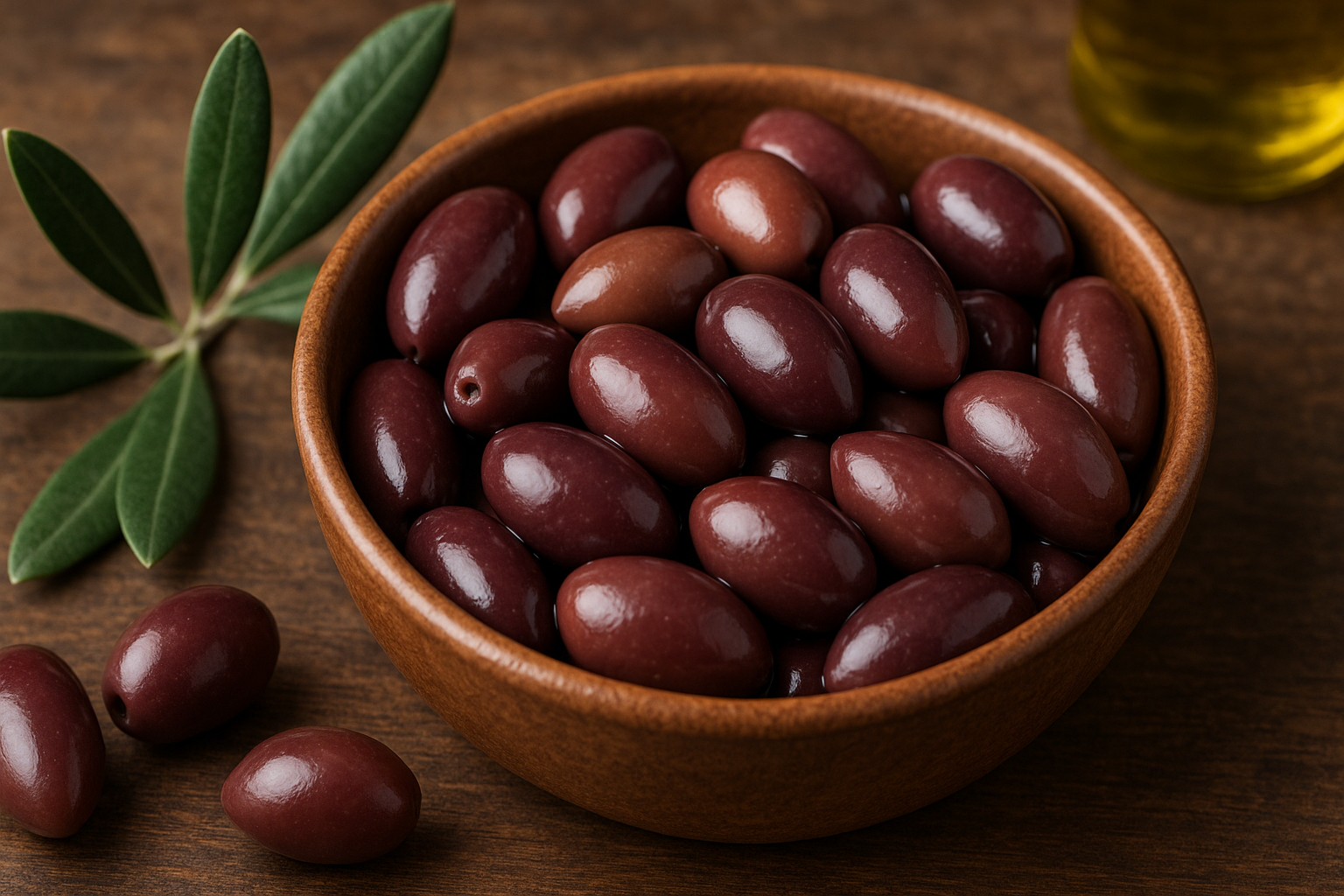Kalamata olives are one of Greece’s most treasured ingredients, loved around the world for their deep purple hue, smooth skin, and bold, fruity flavor. Grown mainly in the southern region of the Peloponnese, especially around the city of Kalamata, these olives have become a defining symbol of Mediterranean food culture.
For centuries, Kalamata olives have been a staple in Greek kitchens, adding character to salads, stews, spreads, and countless traditional dishes. Their balanced taste—a blend of sweetness, salt, and a hint of bitterness—makes them stand out from ordinary table olives. Beyond their unmistakable flavor, Kalamata olives carry a legacy built on heritage, careful farming, and an enduring connection to the Mediterranean way of life.
The Heritage and Origins of Kalamata Olives
The story of Kalamata olives begins in Greece, where olive trees have been cultivated for thousands of years. The region of Kalamata, located in the fertile valley between Mount Taygetos and the Messinian Gulf, offers the ideal climate for producing these distinctive olives—warm sunshine, dry summers, and rich, well-drained soil.
Greek farmers have long considered the olive tree sacred, a symbol of peace and prosperity passed down through generations. Kalamata olives, named after their birthplace, reflect this tradition of respect and patience. Each tree can live for centuries, cared for meticulously by families who treat olive farming as both a livelihood and an art form.
Today, protected by a European “PDO” (Protected Designation of Origin) status, authentic Kalamata olives must come from specific areas in southern Greece. This ensures their quality, authenticity, and a traceable link to their origin. The result is a product that represents not only exceptional flavor but also a deep cultural identity that continues to thrive across the Mediterranean.
Recognizing the Unique Characteristics of Kalamata Olives
Kalamata olives are easy to recognize once you know what to look for. Their color usually ranges from deep violet to dark brown, almost appearing black under certain light. They have an almond-like shape, slightly elongated, with ends that taper gracefully instead of being perfectly round. The skin is smooth and firm, enclosing tender, juicy flesh that bursts with rich, fruity flavor.
Unlike green olives or other black varieties, Kalamata olives naturally ripen on the tree before they are harvested. This natural ripening process gives them their signature richness and full-bodied taste. Their texture is meaty yet soft, offering a satisfying bite that balances briny saltiness with subtle notes of wine and fruit.
Because of these distinctive qualities, Kalamata olives often stand as the centerpiece of dishes rather than a background ingredient. They add not just taste, but personality—a touch of authenticity that transforms even the simplest meal.
How Kalamata Olives Are Harvested and Cured?
The journey from olive tree to table is a careful blend of tradition and skill. Kalamata olives are handpicked to avoid bruising, as their delicate skin can easily tear. Harvesting usually takes place in late autumn when the fruit reaches full maturity and develops its deep, characteristic color.
Once gathered, the olives undergo a meticulous curing process to remove their natural bitterness. Unlike many olive varieties that are lye-cured—a faster industrial method—Kalamata olives are typically fermented in brine or wine vinegar. This traditional approach can take several months but yields a far superior flavor. The olives soak naturally in saltwater, allowing lactic acid fermentation to develop a pleasing balance of saltiness and complexity.
This slow, patient curing is key to what makes Kalamata olives so distinctive. Their taste is layered, with depth and character that simply cannot be rushed. Many small producers in Greece still rely on ancestral techniques, using barrels or clay vessels to preserve the purity of flavor that has been treasured for generations.
The Flavor Profile and Culinary Versatility of Kalamata Olives
The flavor of Kalamata olives is often described as bold, fruity, and wine-like, with a touch of sweetness that lingers on the palate. They are less bitter than many other varieties and have a soft, supple texture that makes them easy to eat whole or slice into dishes.
Their versatility in the kitchen is one of their greatest strengths. In Greek cuisine, they are a core ingredient in the legendary Greek salad, where their saltiness pairs beautifully with fresh vegetables, feta cheese, and olive oil. They also enhance tapenades, pasta dishes, roasted meats, and seafood recipes, adding complexity and depth to each bite.
Modern chefs frequently incorporate Kalamata olives into fusion recipes—from Mediterranean flatbreads and sandwiches to artisan pizzas and even cocktails. Their distinctive flavor makes them suitable for both rustic and refined cuisine. Whether enjoyed as a simple appetizer or as part of an elaborate meal, Kalamata olives bring a touch of elegance and authenticity wherever they appear.
Nutritional Benefits and Health Insights
Kalamata olives are more than just delicious—they are also part of a healthy Mediterranean diet. They are rich in monounsaturated fats, which help promote heart health and maintain healthy cholesterol levels. These “good fats” are essential for supporting the body’s overall well-being and energy.
They are also an excellent source of antioxidants, including polyphenols, which are known for their anti-inflammatory and protective properties. The combination of healthy fats, vitamin E, iron, and calcium makes Kalamata olives a nutrient-dense food that can complement many diets.
Eating Kalamata olives in moderation can support digestive health, provide sustained energy, and even assist in maintaining healthy skin. In many ways, they capture the essence of the Mediterranean lifestyle—a balanced approach to eating, centered around whole, natural foods and mindful enjoyment.
Storing and Preserving Kalamata Olives for Maximum Freshness
Preserving the authentic taste of Kalamata olives requires a bit of care. If purchased in jars or cans, they should be kept in a cool, dark place until opened. Once opened, storing them in their brine inside the refrigerator is essential to maintain flavor and texture.
It is important to ensure the olives always remain fully submerged in liquid, whether brine, olive oil, or a mixture of both. Exposure to air can cause them to lose their rich color and develop a sour taste. When properly stored, Kalamata olives can last for several weeks, retaining their robust aroma and firm bite.
For those who buy olives in bulk, transferring them into airtight glass containers with fresh brine is a simple solution to extend shelf life. Little details like these ensure that each olive tastes as vibrant and flavorful as the day it was prepared.
Kalamata Olives in Modern Mediterranean Culture
In modern Mediterranean life, Kalamata olives remain a source of pride and tradition. They symbolize the strength and continuity of Greek agricultural heritage, connecting past and present through the foods that define the region.
Beyond Greece, these olives have become global ambassadors of Mediterranean cuisine. Their popularity continues to grow in kitchens worldwide, celebrated for their flavor, quality, and health benefits. Restaurants and home cooks alike use Kalamata olives not only for their taste but for the sense of authenticity and warmth they bring to a meal.
In many ways, Kalamata olives remind us of the importance of simplicity—real ingredients, crafted by nature and perfected by human care. Their story is one of connection: between people and the land, between history and the modern table.
Conclusion: Celebrating the Essence of Kalamata Olives
Kalamata olives are more than a food—they are a piece of Greek heritage, preserved through time with devotion and care. From the sun-soaked groves of the Peloponnese to kitchens around the world, they carry the flavor and spirit of the Mediterranean in every bite.
Their rich taste, nutritional value, and cultural importance make them a timeless favorite among chefs, food lovers, and anyone who values simple, honest ingredients. To enjoy a Kalamata olive is to share in a tradition that unites flavor with history, nourishment with pleasure, and nature with craftsmanship.
In the end, Kalamata olives stand as a reminder that some of the world’s finest flavors come from patience, authenticity, and a deep respect for the land that nurtures them.
My name is Mustafa, and I have been blogging for over 5 years. I am passionate about sharing complete, accurate, and helpful information with my readers. Along with managing content on The Matcha Read, I also contribute blog posts to premium websites. My goal is to provide valuable insights in a clear and easy-to-understand way, so every reader walks away with useful knowledge.










